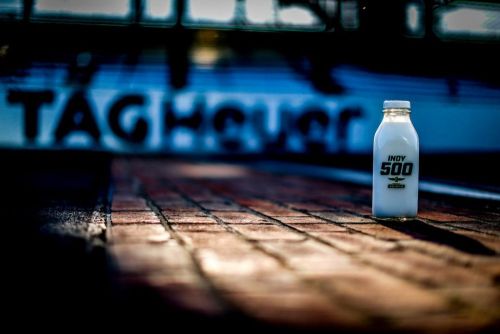
Why does the Indy 500 winner celebrate with milk?
One of the most unique traditions of the Indy 500 is the winner drinking milk. Shortly after parking their car, the winner is given a laurel wreath to wear and then handed a bottle of milk. Only a few sips are taken from the bottle — the rest is often poured over the winner’s face!
 The tradition began in 1936 when Louis Meyer won the Indy 500 for the third time. While recovering on his car from the grueling 4.5-hour race, he was photographed raising his hand in victory with a bottle of buttermilk in the other. Meyer had specifically requested the buttermilk, as his mother had always told him it was refreshing on a warm day.
The tradition began in 1936 when Louis Meyer won the Indy 500 for the third time. While recovering on his car from the grueling 4.5-hour race, he was photographed raising his hand in victory with a bottle of buttermilk in the other. Meyer had specifically requested the buttermilk, as his mother had always told him it was refreshing on a warm day.
The photo appeared in national newspapers the following day and caught the attention of a representative from a major American dairy brand. The company then worked to ensure that winners would celebrate their victory with milk every year.
The tradition of the Indy 500 winner drinking milk didn’t last long initially. Wilbur Shaw, the winner of the 1937, 1939, and 1940 Indy 500 races, became the track manager of the Indianapolis Motor Speedway after World War II. Shaw deemed milk unsuitable for a victory celebration and introduced "Water from Wilbur" in 1947, personally presenting it to winners in a silver chalice.

"Water from Wilbur" met a tragic end when Shaw died in a plane crash in October 1954. For one final year, the winner celebrated with water, but the dairy industry joined forces again to reintroduce milk. Drivers hesitant about drinking milk were persuaded with a $400 prize if they celebrated with the beverage.
Milk drinking has since become one of the most iconic traditions of the Indy 500, and it’s now an integral part of the celebration.
Not every driver celebrates their Indy 500 victory with the same type of milk. Each driver indicates their preference beforehand, with whole milk and 2% milk being the most popular choices. In 2021, Juan Pablo Montoya even selected chocolate milk in case he won.
However, one notable absence from the milk selection list is the type that started it all: buttermilk. It’s no longer offered because today’s buttermilk is vastly different from what was available in 1936 — it was a byproduct of butter production back then.
Source: Indianapolis Motor Speedway
 The tradition began in 1936 when Louis Meyer won the Indy 500 for the third time. While recovering on his car from the grueling 4.5-hour race, he was photographed raising his hand in victory with a bottle of buttermilk in the other. Meyer had specifically requested the buttermilk, as his mother had always told him it was refreshing on a warm day.
The tradition began in 1936 when Louis Meyer won the Indy 500 for the third time. While recovering on his car from the grueling 4.5-hour race, he was photographed raising his hand in victory with a bottle of buttermilk in the other. Meyer had specifically requested the buttermilk, as his mother had always told him it was refreshing on a warm day.The photo appeared in national newspapers the following day and caught the attention of a representative from a major American dairy brand. The company then worked to ensure that winners would celebrate their victory with milk every year.
Milk quickly replaced by water
The tradition of the Indy 500 winner drinking milk didn’t last long initially. Wilbur Shaw, the winner of the 1937, 1939, and 1940 Indy 500 races, became the track manager of the Indianapolis Motor Speedway after World War II. Shaw deemed milk unsuitable for a victory celebration and introduced "Water from Wilbur" in 1947, personally presenting it to winners in a silver chalice.

The return of milk, permanently this time
"Water from Wilbur" met a tragic end when Shaw died in a plane crash in October 1954. For one final year, the winner celebrated with water, but the dairy industry joined forces again to reintroduce milk. Drivers hesitant about drinking milk were persuaded with a $400 prize if they celebrated with the beverage.
Milk drinking has since become one of the most iconic traditions of the Indy 500, and it’s now an integral part of the celebration.
Different kinds of milk
Not every driver celebrates their Indy 500 victory with the same type of milk. Each driver indicates their preference beforehand, with whole milk and 2% milk being the most popular choices. In 2021, Juan Pablo Montoya even selected chocolate milk in case he won.
However, one notable absence from the milk selection list is the type that started it all: buttermilk. It’s no longer offered because today’s buttermilk is vastly different from what was available in 1936 — it was a byproduct of butter production back then.
Source: Indianapolis Motor Speedway
